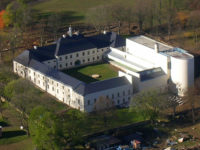Recife, Brazil
Ten miles from the city of Recife on Brazil’s northeast coast, Our Lady of the Conception Chapel, completed by Paulo Mendes da Rocha in 2006—the year he won the Pritzker Prize—shows a reserve that came to the 80-year-old architect late in his career. At the same time, this adaptive renovation, carried out with Eduardo Colonelli, echoes the bold simplicity of the numerous Brutalist buildings Mendes da Rocha designed in his native São Paulo (for the most part) during the latter half of the 20th century.
Commissioned by Brazilian ceramic artist Francisco Brennand, a contemporary and longtime friend of the architect, this eloquent work (also known as Brennand Chapel) was built from the roofless brick ruins of a 19th-century structure on the grounds of the artist’s workshop, the Oficina Brennand, an old family estate and former brick factory that the artist began to redevelop in 1971. Indeed, the two-and-a-half-level, 3,230-square-foot chapel sits on a site of approximately 14,000 square feet in a whimsical complex of lush gardens and restored buildings that includes a museum and sculpture park devoted to the client’s rather extravagant ceramic art.
“The place has a particular monumentality,” says Mendes da Rocha, citing the locale and its proximity to the banks of the Capiberibe River, its soft topography, and dense native vegetation. According to Brennand, the chapel was originally a two-story residence. Subsequently, it served as a school, cinema for factory workers, and shop. To establish a foundation for its new role as a house of worship, Mendes da Rocha collaborated with architect Jorge Passos to restore the masonry. The team removed layers of dirt, moss, plaster, and other coatings from the original walls and partially rebuilt what remained of a surrounding arcade, leaving it open above. A layer of white plaster was applied to both. Mendes da Rocha also designed a concrete bell tower and integrated it with the restored remnants of the arches, recalling the power of his earlier architecture.
The interior manifests a serene transparency, created by an independent glass envelope that wraps the perimeter of the sanctuary 31 inches in from the outer wall. A new, prestressed-concrete slab roof hovers above the masonry wall, resting on two circular pillars positioned on the longitudinal axis of the nave and creating a narrow aperture that’s open to the outside. One of the 31-inch-diameter pillars intersects and braces a raised choir at the back of the room. The choir and the floor, inside and surrounding the chapel, are surfaced with Brennand ceramic tiles fabricated on the property. One level below grade, down a flight of stairs, the architect carved a machine room, and sacristy beyond the footprint of the main body of the chapel. The ceiling’s support system compromises too much of the area below it. Plus it was easier to bring daylight and air to these rooms if they were situated outside the footprint. “What we could maintain of the ruins we did,” explains Mendes da Rocha. “The new is detached from the old in a clear way. Here in the tropics, we didn’t need to enclose the sanctuary totally, so we brought in light and air just below the roof,” says the architect. A baptismal font stands outside the main structure on the side opposite the entrance. Inside the chapel, “there is fresh air and a magnificent silence,” says Mendes da Rocha. “The choir and the belfry sound perfect. The image of the saint on the altar is a very beautiful ceramic by Brennand.”
In plan, the architect’s scheme accommodates the irregularity of the crumbling original walls, while imposing a rectangular rigor on the composition. The massive roof “floats,” separated from a place that is older in its essence. Mendes da Rocha handles the complex task of converting a ruin to a new purpose with a deftness that avoids both historical pastiche and heavy modern intervention. He also exploits the texture of materials—contrasting smooth glass, poured-in-place concrete, and rugged masonry. Such manipulation of materials is nothing new for Mendes da Rocha. At the State Museum of São Paulo (1993), for example, he skillfully juxtaposed old brick walls and modern interventions, converting a late-19th-century school to a new use. At the Brazilian Museum of Sculpture (São Paulo, 1988), he contrasted the heaviness of a cantilevered concrete slab with an open space below. And at the residence he designed for Mario Masetti (São Paulo, 1988), he willfully combined concrete with a rough stone wall.
A “late” work in the career of Mendes da Rocha, the Brennand Chapel shows the architect mastering the art of understatement, something not always found in his earlier buildings with their grand formal gestures. According to the architect, his keen interest in the Brennand Chapel stemmed from the challenge of reviving a building found in ruins and charged with history and emotion, as well as a desire to create a discourse between different eras. Talking about the chapel, he explains, “The new part is an entirely distinct design—two columns and a roof in prestressed concrete. The old remains as it was. It is a collage of the past, the present, and the future.”




Post a comment to this article
Report Abusive Comment